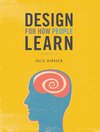
Saved by Sara Silva and
Design for How People Learn (Voices That Matter)

Saved by Sara Silva and
Peer-to-peer feedback.
Self-evaluation. You can create opportunities for the learner to self-evaluate by giving them criteria, reflection questions, or examples that they can compare their performance to.
The best way you answer these questions = Watch actual learners use your design.
We can’t make anybody learn, but we can make much better learning environments for them and help each learner be the hero of their own learning journey.
Tools that you can use to create feedback consistency include checklists and rubrics.
To do evaluation well, you should start by defining what you are trying to evaluate. Some of the things you might want to know include: • Does my learning design function well? • Are the learners actually learning the right things? • Can the learners actually do the right things? • Are the learners actually doing the right things when they go back
... See moreOne of the things you need to consider when putting knowledge into the world is the proximity of the knowledge to the task. By this I mean, how far from the task does the learner have to go to get the knowledge?
Help tie the habit to an existing behavior. Help learners identify an existing behavior they can chain the new habit to.
How can we make behaviors more visible and reinforce practice?